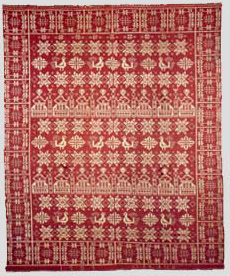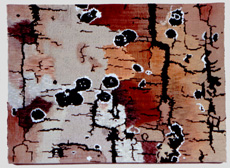|
Layers of Meaning exhibits
textiles by eight contemporary artists from across the United
States. Each of these weavers uses pick-up double or triple weave
to interweave two or more layers of warp (the lengthwise thread
on a loom) to create intricate, reversible patterns or pictorial
textiles.
A Short History
Pick-up double weave describes
a weave structure that originated in both the old world and the
new, in diverse cultural traditions. Pick-up double cloth was
woven in coastal areas of Peru and the techniques were handed
down for millennia in Andean cultures, where the best pieces
were burnt as offerings to the sun god. In Asia, double-woven
cloth was one of a number of weave structures used to create
silk fabric, which was traded to secure alliances, military protection
and loyalty. Early weavers embraced the technique during the
Middle Ages when the Vikings brought examples back to Scandinavia.
From that time on, Scandinavian weavers, particularly in Norway,
used pick-up double weave to create pictorial tapestries, coffin
covers, coverlets and other goods useful in a cold climate.


In early example, which
depict events such as bridal processions, plants and animals
carry rich symbolic imagery. These meanings dissolved over time
into coverlet patterns of conventionalized folk art forms.
Current Practice
Some artists in this exhibit
use traditional methods as a jumping-off point. Eileen O'Brien
trained to weave double cloth while living in Sweden. Once back
in the U.S., she began to create textiles to reflect her personal
vision, rather than the folk art motifs she had been taught.
|
|
W. Logan Fry also learned
pick-up double weave in the Norwegian tradition. His work, however,
reflects his interest in technology and its use in recording
and transmitting information
George-Ann Bower's works
reflect a mastery of layered textile art. Her weavings take their
inspiration from nature and geophysical forms.
 Aspen
Aspen
George-Ann Bowers ©2001
Some have adopted pick-up
double weave as a natural extension of their exploration of loom-controlled
forms. Paul O'Connor manipulates double-woven threads to create
patterning he could not achieve by threading and treadling alone.
Jan Doyle achieves her playful, symbolic designs by visualizing
them as she weaves, working from a small-scale drawing. Marie
Westerman taught herself to use the interweaving layers of threads
to render detailed photorealistic imagery.
Being self-taught can lead
to a habit of pushing possibilities. Jennifer Moore developed
a unique approach, with one layer set up in a twill pattern.
Her work explores geometric patterning and mathematical progressions.
Elizabeth Kuhn, like some
of the other artists, adds a third full layer of warp and weft
threads to increase color and visual impact in work that expresses
her social and political concerns.
Conclusion
Invention and departure
from convention are hallmarks of fine art. In the 20th century,
many artists resurrected traditional crafts, then created new
works imbued with their own personal outlook and meaning. Each
of the artists in Layers of Meaning recognizes something
about double weave that causes them to devote their careers and
entrust their vision to this textile form. Always a challenging
form of hand-weaving, it continues to fascinate artists with
the expanding possibilities that accompany the interlacement
of warp and weft.
- Marie
Westerman
.
|